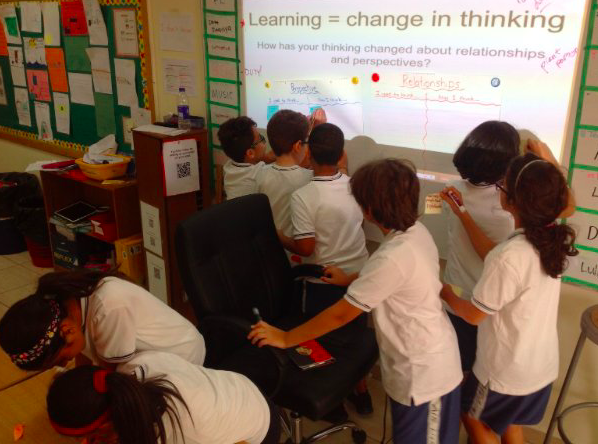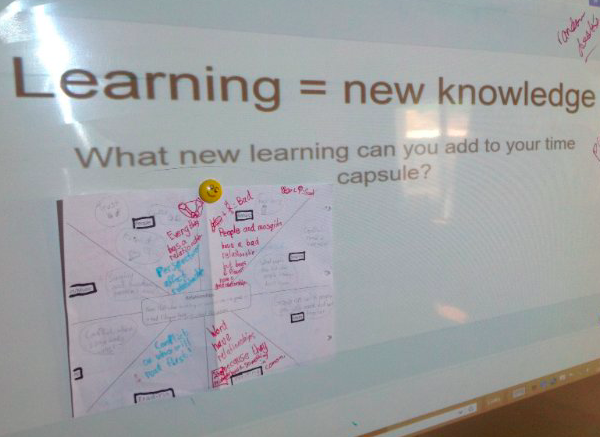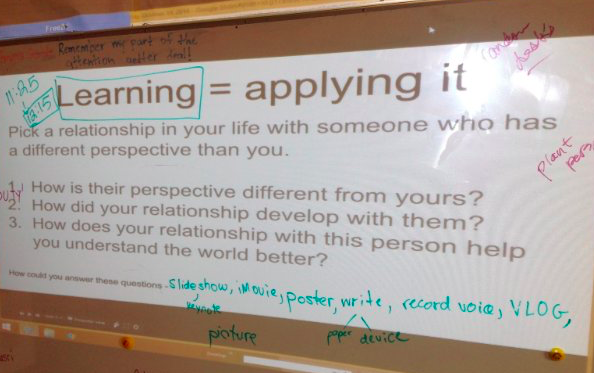This year I have tried to approach assessment differently. I wanted my students to feel that assessment is something I do with them… not to them.
I have made many shifts in my assessment practices to try and accomplish this goal:
Discussions about assessment
As a class we discussed the difficulty of trying to measure a human’s learning and I shared that there are many different approaches to trying to figure out what a student has learned in school. We discussed a handful of approaches for measuring learning and then we tried each of them out within the context of our unit.




Co-constructed success criteria
Instead of teachers sitting behind closed doors, deciding what ought to be learned by the end of a unit, I made those decisions collaborative with my students. I used the structure of growing definition where first students brainstorm on their own, then they combine ideas with a partner, then they merge thinking with another set of partners, then a foursome with a foursome and so on until the whole class builds a list together. Once their student list was created, I consulted our school curriculum documented and added any knowledge or concepts they might have left out. This list then became our success criteria that we used throughout the unit.
Student chosen summatives
Teachers and teaching teams spend hours, upon hours, discussing and trying to figure out how students can best show their learning at the end of a unit. This year, instead of choosing that choice for them, I handed that decision over to my students. When we approached the end of the unit, I would ask “How best can you share your learning from this unit?” Some students who felt most comfortable expressing themselves orally would submit a vlog or request a one-on-one conference, other students who felt they best expressed themselves in writing would submit a written text, and others who felt they could best express themselves visually would produce a mind map, or concept map or cartoon – some sort of visual to convey their new thinking and new knowledge.
Triangulation of perspectives
Oftentimes as teachers we are the only – and ultimate – voice of assessment. Sometimes we tokenistically invite self and peer assessment, but rarely are those assessments equally valued. So this year I wanted to take a flatter, more democratic approach to assessment. Whether it was diagnostic, formative or summative, we always followed the same three steps: first the student would assess themselves, next they would find a peer to offer their perspective, then purposefully last, I as the teacher would share my perspective. What they end up with, is three different perspectives… all equally valued.
Interchangeability of diagnostic, formatives and summatives
Instead of approaching diagnostic, formative and summative assessments as assessments that you do at the beginning, middle and end of a unit – I took a much more fluid approach. If a student did a diagnostic and demonstrated all the knowledge and skills that were expected they could decide to use that as their summative and then either choose to extend themselves in this area of continue with a personal inquiry of their choice – thus the diagnostic becomes the summative. If partway through the unit a student demonstrates the required knowledge and skills, then that formative can then become their summative and they would have the same choice of extending or free learning. And finally, on the “last day” of the unit if a student completed a summative and had not yet demonstrated the necessary knowledge and skills they could choose to continue to learn, and therefore turn that summative into a formative and re-take the summative at a later time when they felt ready.
Decision making conferences
When it came time to enter “final marks” into the report card, I would sit with each student individually and have a conversation about where they thought they were in their learning. They would look back at the assessment data and tools and share where they thought they were and then I would do the same. Together we would agree on a mark that we both felt comfortable putting on the report card.
Taking it to the next level…
All in all, it was a great change in practice! I think my students felt empowered to have a voice in their learning and in the measurement of their learning. I think students felt their perspectives were respected and valued. And on a personal level, it felt much more humane and much more like a partnership in supporting their learning journey!
Upon reflections from this year and visions for next year, here are a few ways that I would like to take the approach of ‘doing assessment with students’ even further:
Individualized success criteria
I enjoyed the process of co-constructing success criteria with my students, but to take that further I would love to personalize that process even more and have students design their own individual success criteria. Flipping the question “What should we learn but the end of the unit?” more towards “What should I (or do I want to) learn by the end of the unit?” This would open up some great conversations with students about choosing how they might know they have been successful at learning something or acquiring new skills. Here is a blog post with an example of how one teacher approached this.
Beyond triangulation of perspectives
This year I think I did a pretty good job shifting the assessment power away from myself as a teacher, and equally distributing it between myself, the student and a peer. However, I would like to push that model further and perhaps figure out a way to include the perspective of parents, industry experts or community members. I don’t think it would have to be all 6 sources every time. I think there could be a lot of authentic learning in having students decide which assessment perspective is most helpful in a specific situation.
Student written report cards
The only part of the assessment process my students were kept out of this year was reporting. Moving forward I would love to see students take a more equal role in writing their own report cards. Here is a great blog post with some suggestions I hope to be able to follow in the future.
How do you ensure assessment is something done “with students” not “to students” in your classroom or school?












